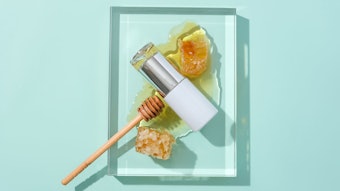To date, contributions from this author have focused on attributes and scientific parameters primarily associated with shampoos and conditioners. This contribution switches focus to quantifying technical characteristics associated with hair styling products. There are two general classifications of such products: those that help with style creation, and those that prolong the style. The benefits of conditioner-induced surface lubrication have been heralded in a previous contribution;1 but there is a downside when it comes to styling, as the smooth surface inhibits the ability to effectively grip and manipulate the hair with a brush. Both mousses and hair gels aid with this issue, and represent the primary product forms for facilitating style creation. Meanwhile, hair sprays (both aerosol and non-aerosol) are generally used to promote longevity after the styling process.
Technically, the benefits of both styling and hold stem from the presence of water-soluble polymers in formulations. In mousses and gels, these polymers induce a rheology that creates cohesion, and possibly a degree of tackiness, to allow hair to be gripped with the brush. In hair sprays, aerosolized droplets of polymer solutions deposit on the hair that, after evaporation of the solvent, “glue” the hair array or style together through the creation of “spot welds” and “seam welds” between fibers.
Hair spray has been in the crosshairs of regulatory bodies seeking to minimize volatile organic compound (VOC) emissions. This goal created a great deal of R&D activity in the mid-to-late 1990s, as ingredient manufacturers and end product companies expended considerable efforts in attempt to maintain product performance under trying new conditions. Those involved in the category at the time will recall a proliferation of new polymers and formulation strategies that necessitated the need for comprehensive technical characterization. Herein and in a future contribution, the techniques this author found particularly worthwhile toward this proliferation, and that continue to remain useful today, will be described.
Challenges of Consumer Language
There continues to be a need to understand how consumers talk about products, and to compare and contrast this terminology with technical knowledge. In short, “consumer language” and “technical language” often do not equate. For example, a quick survey of advertising and product packaging for styling products highlights the widespread use of the word hold. Specifically, there is desire for optimal hold but without sensorial negatives; i.e., a stiff, unnatural feel to the hair—a condition often lightheartedly referred to as “helmet head.” As such, there is an apparent trade-off whereby high hold is generally attained at the expense of poor feel, while sensorial improvements often result in a diminished perception of hold. There is an obvious tendency to equate “hold” with “style longevity”—a presumption that will be revisited later. However, the present paper begins with the most commonly used evaluation technique for style longevity, which involves some version of a high-humidity curl droop experiment.
High-humidity Curl Droop Experiments
High humidity represents an especially torturous environment for hair styles; therefore, longevity experiments are frequently performed under these challenging conditions. A previous article2 described how such an environment leads to hair adsorbing high quantities of water, which adds extra weight while also plasticizing (softening) hair’s internal structure. Water-set styles are quickly destroyed under these conditions but the application of hair sprays can effectively prolong the shape.
Most hair testing laboratories perform some version of a high-humidity curl droop experiment. There are numerous variations, the main differences being in the means of setting hair. Assessment first involves allowing treated hair to dry and equilibrate in a specific conformation, preferably under low-humidity conditions. This can be carried out using various commercially available curling rods—although personal preference involves the use of pegboards such as that shown in Figure 1. The predilection for this choice relates to the ability to remove hair from the template with minimal disruption to the newly set state. This example also contains a lift-plate, which allows for the easy removal of tresses without the need to peel hair from the setting tool. The pegs are also coateda to further aid the removal process.
Tresses are then hung inside a controlled humidity chamber, and the length of the hair is determined as a function of time after raising the relative humidity. This process can be quantified by simply measuring with a ruler; however, today’s digital photography and image analysis techniques represent a faster and more elegant approach. Figure 2 shows a curl droop test in progress. The upper eight tresses represent untreated control samples rapidly losing their shape at an elevated humidity, while the lower eight tresses were treated with hair spray, and visibly demonstrating better shape retention.
The extent of this reversion/droop can be expressed as a percentage relative to the initial and final lengths of the tresses using Equation 1:
% Curl Droop = 100 × (Lt – Lo)/(L – Lo) Eq. 1
where Lt = length of tress at time t; Lo = initial length of curled tress, and L = length of fully extended tress.
Needless to say, it is necessary to include sufficient replicate samples to perform robust statistical analyses. Figure 3 shows a typical set of experimental results that demonstrate the ability for commercially available products to prolong style retention over six hours of exposure to 80% relative humidity. Here, it is only fair to give credit to this early method’s pioneers; the earliest reference to this author’s knowledge involves the work of Micchelli and Koehler3 in 1968. However, it is also worth noting the similarity to still-earlier methods for evaluating the efficiency and longevity of permanent wave products.4
Tress Stiffness Measurements
As mentioned, the application of a styling product is generally accompanied with an increase in the stiffness of the hair array, and quantification of this effect is often desired. A number of references can be found in the literature whereby mechanical testing equipment was used to measure the forces necessary to deform or compress prepared hair samples. A common approach is the Tolgesi Omega Loop method, in which one measures the force it takes to compress a loop of fibers shaped to resemble the Greek character Ω. In actuality, the original article5 utilized this approach as a supposed measure of the esoteric consumer attribute for hair “body,” and made no mention of styling products. However, the use of this set-up to evaluate increased stiffness due to styling products is a natural extension of the method. This adaptation has been described in a series of paper by Jachowicz.6-8
From a mechanical testing perspective, it is considerably easier to model the deformation of a flat object than a loop. Accordingly, this author prefers performing stiffness measurements on flat hair tresses in a three-point bending geometry, sometimes termed a dual cantilever, as shown in Figure 4. A treated flat hair tress is placed between two supports, and is then depressed in the center by the mechanical tester. Recently, a similar single cantilever approach has been described.9 While test geometry may differ, the underlying principle is clearly the same: namely, the presence of styling polymer deposits promote increased stiffness in the hair array, which registers in terms of higher deformation forces. A further variation of the method may involve cycling the applied deformation to determine the resiliency of the crust; i.e., earlier deformations may break a portion of the crust and lead to lower forces on subsequent cycles.
Product Application Considerations
It is necessary to emphasize that the performance of any product or formulation is highly dependent on the way it is used. Therefore, precise and reproducible product application conditions are imperative to generate quality data. Indeed, this author believes that variability associated with product application represents the single biggest source of error in virtually all laboratory evaluation techniques. This can be especially troublesome with sprays, which are difficult to consistently apply in part due to the actuation properties of the package. Accordingly, a given formulation can produce quite different outcomes if used in association with different hardware.
It is also worth noting that the film properties of a deposited polymer will be highly dependent on environmental conditions. Water is a plasticizer for polymers; consequently, their mechanical properties including stiffness can change dramatically with relative humidity. This point will be discussed in greater depth in the next contribution from this author [anticipated for September 2014]. For now, it is simply emphasized that controlled humidity conditions are necessary for a reproducible test environment.
Summary
The present article discussed the concept of hold vs. feel trade-off, whereby maximum hold is accomplished at the expense of poor feel while improved feel generally results in the perception of reduced hold. However, an alternative view of this situation may be that hair stiffness is indeed the consumer cue for hold. In support of this notion, it is noted that when women are asked to assess the “hold” level of a product, it rarely involves visual inspection but commonly involves touching the hair. In fact, continued analysis of consumer feedback suggests that stiffness has a dominant and possibly over-riding influence on a great number of sensory attributes—including hair style longevity, manageability and washability.
In short, while consumers profess the desire for a product that creates a style that feels flexible, stiffness appears to provide the reason for consumers to believe in its performance. Consequently, it seems likely that results from stiffness measurements may correlate more closely to the consumer term hold than do longevity tests.
The methods described in this paper represent the most iconic evaluation approaches for hair spray. The next contribution from this author will describe additional complementary techniques that further probe the properties of deposited polymer films and their interactions with hair.
Continue to Part 2 ...
References
1. TA Evans, Evaluating Hair Conditioning with Instrumental Combing, Cosm & Toil 126(8) 558-563 (Aug 2011)
2. TA Evans, Measuring the water content of hair, Cosm & Toil 129(2) (Mar 2014)
3. AL Micchelli, FT Koehler, Polymer properties influencing curl retention at high humidity, J Soc Cosmet Sci 19, 863-880 (1968)
4. DH Kirby, The waving efficiency of cold permanent wave lotion, Drug and Cosmetic Industry 80(3) 314-400 (1957)
5. EY Naling, RH Kissinger, WS Tolgyesi and EM Cottington, The effect of fiber diameter on the cosmetic aspects of hair, J Soc Cosmet Sci 28, 139-150 (1977)
6. J Jachowicz, K Yao, Dynamic hair spray analysis I. Instrumentation and preliminary results, J Soc Cosmet Sci 47, 73-84 (1996)
7. J Jachowicz, K Yao, Dynamic hair spray analysis II. Effect of polymer, hair type and solvent composition, J Soc Cosmet Sci 52, 281-295 (2001)
8. J Jachowicz and R McMullen, Mechanical analysis of elasticity and flexibility of virgin and polymer treated hair fiber assemblies, J Soc Cosmet Sci 53, 345-361 (2002)
9. P Hoessel, S Riemann, R Knebl, J Schroeder, G Schuh and C Castillo, Assessment of styling performance in hair gels and hair sprays by means of a new two-point stiffness test, J Soc Cosmet Sci, 61, 343-352 (2010)










